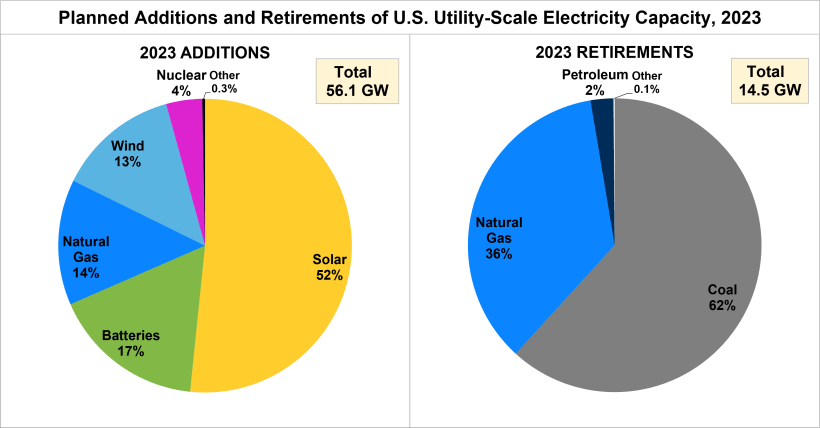
In 2023, Non-Fossil Fuel Sources Will Account for 86% of New Electric Utility Generation Capacity in the United States
Amid the transition to an electrified transportation sector, efforts to decarbonize the U.S. power grid are evident in the planned additions and retirement of utility-scale electricity generating capacity. For 2023, added capacity will come primarily from solar (52%) and wind (13%), while batteries for stored energy will provide 17% of the new capacity.
Natural gas is the only fossil fuel type contributing to new capacity and will account for 14% of the total. In contrast, nearly 100% of the capacity being retired is based on fossil fuel, led by coal (62%) and natural gas (36%). A total of 56.1 gigawatts (GW) of new capacity is being added and 14.5 GW of current capacity are being retired for a net gain of 41.6 GW in capacity.
Notes:
- Net summer capacity.
- Utility-scale electricity capacity is measured for electric power plants with at least one megawatt of total electricity generation capacity.
- “Other” on the ADDITIONS chart includes biomass, petroleum liquids, conventional hydroelectric, geothermal, and landfill gas.
- “Other” on the RETIREMENTS chart includes landfill gas, conventional hydroelectric, and wood/wood waste biomass.
Courtesy of U.S. DOE’s Vehicle Technologies Office. Source: U.S. Energy Information Administration, Electric Power Monthly, February 2023, Tables 6.5 and 6.6.
I don’t like paywalls. You don’t like paywalls. Who likes paywalls? Here at CleanTechnica, we implemented a limited paywall for a while, but it always felt wrong — and it was always tough to decide what we should put behind there. In theory, your most exclusive and best content goes behind a paywall. But then fewer people read it! We just don’t like paywalls, and so we’ve decided to ditch ours. Unfortunately, the media business is still a tough, cut-throat business with tiny margins. It’s a never-ending Olympic challenge to stay above water or even perhaps — gasp — grow. So …





